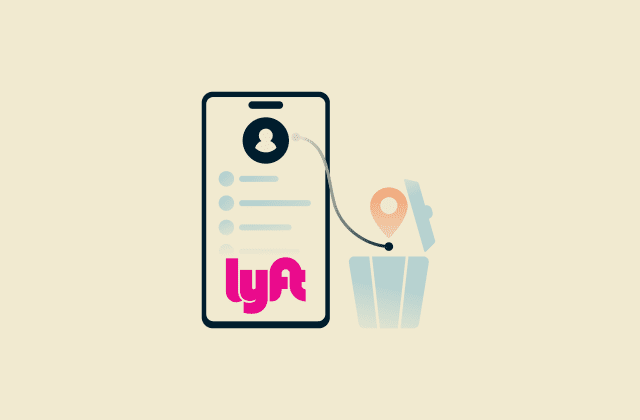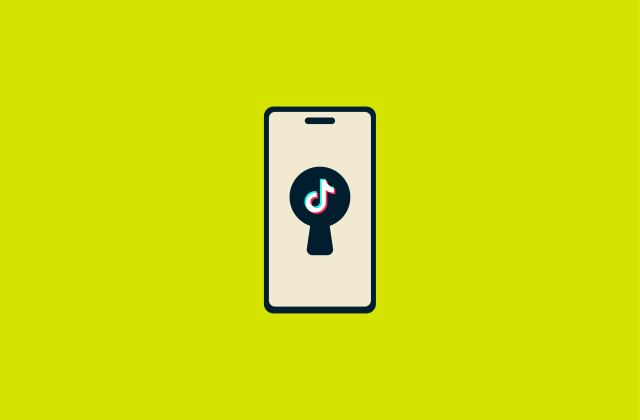IoT cloud security: Threats and best practices

Most Internet of Things (IoT) environments rely on cloud infrastructure to manage device data at scale. However, the size and complexity of these deployments can introduce security gaps that put sensitive information at risk.
This guide outlines the most common IoT cloud threats and provides practical security recommendations to help organizations strengthen their defenses.
Note: This article focuses on IoT cloud security for organizations and IT teams. While consumer virtual private networks (VPNs) like ExpressVPN can help secure smart-home IoT devices, they serve a different purpose than the enterprise-level solutions discussed here.
What is IoT cloud security?
IoT cloud security is the set of practices, policies, and technologies that protect IoT data and device interactions within cloud environments. It focuses on securing data in transit and at rest, ensuring devices can prove their identity to cloud services, and controlling which devices and applications can access cloud resources.
Common vulnerabilities in IoT cloud ecosystems
Cloud security depends on the integrity of the devices feeding into it, and inherent IoT vulnerabilities can extend directly into the cloud backend.
Insecure communication and edge-to-cloud data flows
IoT connectivity relies on continuous data transfers between devices, servers, and cloud infrastructure. When these connections use weak or misconfigured encryption, attackers can intercept or modify data before it reaches the cloud.
Edge-to-cloud architectures add more points where data can be compromised. Edge devices process information locally, then forward it to the cloud for storage or analytics. If any hop in that chain lacks encryption or integrity checks, attackers can slip falsified or altered data into cloud systems. This affects the accuracy of cloud analytics, triggers incorrect alerts, and can even disrupt automated cloud-driven processes.
Device-level security gaps
Even with strong cloud protections, insecure IoT devices can undermine the whole system. Many IoT products still ship with predictable problems, like default credentials, poorly protected keys, and firmware that doesn’t receive regular updates.
When a device is compromised, the attacker inherits its cloud permissions. They can authenticate to the cloud as a trusted client, call APIs, or feed manipulated data into cloud services.
IAM, authorization, and privacy issues
Misconfigured identity and access management (IAM) roles, shared credentials, and overly broad permissions can let spoofed or unauthorized devices connect to cloud services and access data or functions they shouldn’t. These gaps give attackers a way to reach cloud APIs, view sensitive information, or issue commands through compromised devices.
Since IoT deployments push large amounts of sensitive and sometimes regulated data into the cloud, like IoT public safety metrics, IAM-related errors may have serious consequences. For example, it could violate IoT data privacy and compliance regulations like the General Data Protection Regulation (GDPR) or the International Organization for Standardization (ISO) 27001.
Key challenges in securing IoT cloud environments
Securing the devices and infrastructure that feed into the cloud is often difficult in practice due to several characteristics of IoT ecosystems.
Device diversity and fragmentation
IoT networks often combine devices from different vendors, using different operating systems, chipsets, firmware versions, and security capabilities. Many devices also rely on third-party hardware components, software libraries, and cloud-facing APIs. This fragmentation makes it difficult to apply consistent security controls and increases the chances that a single weak device becomes an entry point into cloud services.
Hardware limitations
Many IoT devices run on minimal hardware, which restricts how much security they can realistically support. These technical limitations reduce how much protection can be built into the device in the first place, leaving cloud environments dependent on clients that can’t meet typical security standards.
Large-scale identity and lifecycle management
Cloud platforms need to authenticate and authorize every device that connects to them, but large IoT deployments can involve thousands or even millions of devices. Managing identities, certificates, and permissions at this scale, and keeping them correct as devices are deployed, updated, or retired, is difficult. Any lapse in this process can give unauthorized devices access to cloud services or expose cloud-stored data.
Best practices for robust IoT cloud security
Efficient IoT cloud security requires a comprehensive approach that covers multiple areas. The section below outlines key best practices that help organizations strengthen protection across all layers of the IoT ecosystem.
Strong authentication and access control
Devices and users must prove their identity before they interact with cloud services. Organizations typically achieve this through:
- Unique device identities, often stored in hardware and verified with device certificates.
- Secure onboarding methods, like pairing codes, hardware buttons, or cryptographic proof of ownership.
- Removing default passwords and enforcing strong, unique credentials.
- Multi-factor authentication (MFA) for user accounts accessing cloud dashboards or controls.
IAM systems help enforce these measures at scale by centralizing authentication and permissions. With that foundation in place, teams can then use permission models like role-based access control (RBAC) to give each device or user only the access required for their role.
Data encryption: At rest and in transit
Strong encryption keeps data protected at every stage: it prevents IoT attacks like interception or tampering while it’s being sent to the cloud and can stop unauthorized access once it’s stored there.
Organizations can enforce this by using secure communication protocols like Transport Layer Security (TLS), enabling encrypted storage in the cloud, and relying on private connections or using enterprise VPNs when needed.
For devices that can’t support strong encryption due to hardware limits, isolating them on subnets is a practical short-term measure until upgrades are possible.
Secure cloud architecture and network segmentation
The way the cloud backend is organized has a big impact on IoT security. A good structure keeps issues contained and limits what an attacker can reach. Key practices include:
- Separating cloud workloads: Keep ingestion, processing, and storage functions isolated so each service operates within its boundaries and permissions.
- Protecting cloud APIs: Enforce strict request validation, apply rate limits, and use tightly scoped tokens to prevent abuse of device-facing endpoints.
- Validating data at the cloud edge: Filter incoming data for correct formats, expected values, and unusual patterns before it’s passed deeper into cloud systems.
- Applying zero-trust principles: Continuously verify identities and segment access paths so no device or service can reach more than it genuinely needs.
Continuous monitoring, logging, and patch management
Monitoring network traffic, device activity, and system interactions helps teams understand what “normal” activity looks like and quickly spot anything that deviates from it. Organizations can also leverage AI-powered tools to identify suspicious patterns. Logging plays a key role, too. Centralized logs make it easier to trace issues, investigate incidents, and understand how devices and cloud services behaved before and during an event.
Finally, consistent patching, especially through over-the-air updates, reduces the window in which known vulnerabilities can be exploited. Other best practices include enabling automatic updates, maintaining an inventory of deployed software (including version and patch status), and using version control mechanisms to prevent attackers from downgrading device firmware.
Securing IoT cloud connections with VPN integration
VPNs play an important role in protecting IoT traffic on its way to the cloud, adding an extra layer of privacy and reducing exposure to untrusted networks. But despite their security benefits, VPNs aren’t suitable for every IoT cloud scenario.
Note: This section primarily discusses enterprise-level VPN setups used to secure IoT traffic to the cloud. This is distinct from consumer VPNs applied at the device or router level in smart-home setups.
When and why to use VPNs for IoT
You should consider using a VPN for IoT when:
- Devices operate on public or shared networks: Smart sensors, industrial equipment, or remote assets that use Wi-Fi hotspots, cellular networks, or third-party infrastructure benefit from a protected communication path.
- You need to hide cloud endpoints: VPNs allow devices to connect to internal cloud services without exposing APIs or management interfaces directly to the internet.
- Data privacy requirements are strict: Industries like healthcare, smart cities, and manufacturing often handle regulated or highly sensitive data. VPN encryption helps keep this data confidential during transit.
- Devices lack strong built-in security: Older or resource-constrained devices may not support modern protocols like TLS. A VPN can provide a layer of protection by encrypting the network path they use (though the data inside the device will remain unencrypted).
- You want consistent, centralized access control: VPN gateways create a single point where you can enforce authentication, verify device identities, and monitor traffic, which is useful for large deployments.
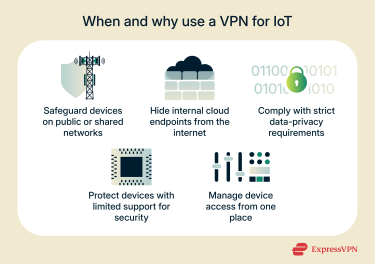
VPN gateway vs. device-level VPNs
There are two common ways to integrate VPNs into IoT environments: through a centralized VPN gateway or by running a VPN client on each device.
A VPN gateway is a network device that encrypts communications between entire networks, such as on-premise environments and cloud infrastructure. Devices connect to the gateway, and the gateway establishes and maintains the VPN connection to the cloud.
Device-level VPNs, on the other hand, are set up on individual devices, either through manually configured connections or installed VPN apps. Most IoT deployments rely on VPN gateways. Device-level VPNs usually make sense only when hardware can support them and when tight, per-device isolation is a hard requirement.
Recommended VPN protocols
VPN protocols determine how a VPN connection is established and data is encrypted. Depending on the VPN setup, several protocol options are available for protecting IoT connections:
- OpenVPN: Provides strong security and good speeds and is widely supported on business-grade and consumer routers, as well as mobile apps.
- WireGuard: Has a lightweight design that balances security and high-speed connections. Most mobile VPN apps support WireGuard, though support may vary across router models.
- IPsec: A common choice in enterprise IoT deployments, as it generally secures data transfers between connected devices and centralized management platforms.
- IKEv2/IPsec: Delivers fast speeds and stable connections and is also common in Android and iOS apps. Router compatibility depends on the hardware, so availability may be more limited compared to other protocols.
- Lightway: A lightweight protocol designed for speed and reliability, offering high-end security and privacy. It’s ExpressVPN’s proprietary protocol, primarily used in consumer and smart home setups via routers and mobile apps.
IoT cloud security checklists and privacy protection with VPNs
Here are some practical security checklists for each stage of an IoT cloud project, along with common configuration pitfalls to watch for.
Pre-deployment IoT security checklist
Before rolling out IoT devices and enabling VPN connectivity, organizations should verify that device configurations, identities, and network design are secure. This can prevent vulnerabilities from affecting authentication, performance, or data protection later on.
Validate device firmware and secure boot
Establishing firmware-level trust is an essential first step, since outdated or compromised firmware can expose VPN credentials or allow attackers to tamper with device traffic.
- Update to the latest manufacturer firmware: New releases often fix known vulnerabilities, so updating devices before deployment closes security gaps attackers commonly target.
- Verify firmware integrity: When possible, confirm that installed firmware matches the manufacturer’s original files by checking hashes or signatures. This helps ensure the firmware hasn’t been tampered with or replaced during shipping or installation.
- Enable secure boot: Secure boot only allows trusted, cryptographically signed software to run when the device starts up. This prevents attackers from loading altered or malicious code early in the boot process.
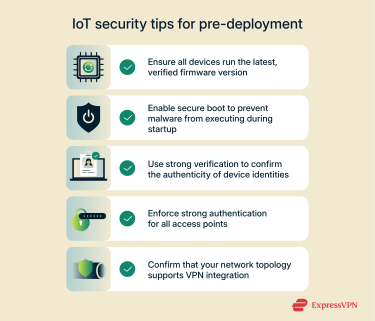
Provision device identity and credentials
Devices need identities the network can reliably verify. This usually means giving each device its own cryptographic identity, like a certificate or hardware-bound key, so the VPN gateway can confirm it’s talking to the right device. Devices should present these credentials during onboarding or tunnel setup, which makes sure only legitimate, pre-registered devices gain access to the cloud environment.
Assess network topology for VPN compatibility
Before enabling VPN connectivity, organizations should verify that their IoT network can support the added encryption and routing requirements.
- Assess device-to-gateway paths: Ensure the existing network topology can route VPN traffic without creating bottlenecks or breaking communication flows.
- Verify protocol support: Confirm that routers and gateways support the VPN protocol you plan to use and can process encrypted traffic at the required throughput.
- Evaluate performance impact: Make sure VPN encryption won’t slow down time-sensitive IoT data or overload low-power devices.
- Confirm scalability: Ensure VPN gateways can handle the number of devices expected to connect, both now and as the deployment grows.
Cloud configuration security checklist
When an IoT deployment uses a VPN for device-to-cloud communication, the cloud side needs to be set up in a way that fully supports that encrypted tunnel.
IAM policies and role segregation
Only a small set of cloud identities should be allowed to manage VPN gateways, routing rules, certificates, and device registries. Applying least-privilege access prevents routine cloud users from changing settings that affect how devices connect through the tunnel.
It also helps to separate responsibilities: the role that provisions devices, the role that configures cloud services, and the role that manages VPN infrastructure shouldn’t belong to the same account. Keeping VPN administration isolated reduces the risk that a single compromised user could modify routes, weaken encryption settings, or open unintended access paths into the cloud.
Encrypted tunnels for device-to-cloud traffic
Once integrated, ensure that VPN connections correctly route encrypted data from IoT components to cloud networks. Verify that routing tables are properly configured, since they determine the paths traffic takes across the network. Misconfigurations can create serious security gaps, such as traffic bypassing the encrypted tunnel or failing to reach the VPN gateway at all.
Remember that VPNs should complement and not replace built-in encryption methods like HTTPS or Message Queuing Telemetry Transport (MQTT) over TLS. Using multiple layers of protection ensures device-to-cloud traffic remains secure even if one control fails.
Logging, auditing, and monitoring via VPN logs
If not enabled by default, administrators in IoT cloud environments should activate logging across all VPN gateways. Organizations can analyze these valuable connection and usage metrics to identify potential device errors, misconfigurations, or security vulnerabilities.
Post-deployment monitoring and privacy assurance
Once IoT devices are online, the work isn’t over. Organizations still need to watch encrypted traffic, track VPN activity, and keep encryption practices up to date to protect device communications over time.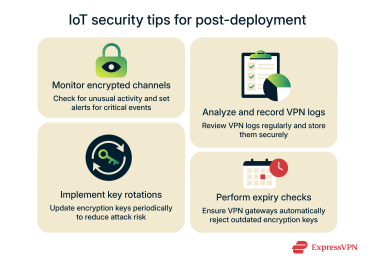
Anomaly detection on encrypted channels
VPN gateways generally provide detailed logs that help identify unusual activity on encrypted connections. Examples may include repeated failed authentication attempts, sudden spikes in session duration or data usage, unknown source IP addresses, or devices connecting outside normal operational hours.
Alerts should also be enabled so IT teams can quickly investigate issues, troubleshoot configuration errors, or identify potential vulnerabilities. Administrators should monitor which devices and users establish VPN connections and what cloud resources they access.
VPN logs for forensics and compliance
Centralizing logs from all VPN gateways makes it easier to audit activity and investigate incidents. Consolidated logs help security teams trace unauthorized access attempts, follow how users and devices move through the network, and even reconstruct cyberattacks to better understand how to combat them.
Additionally, these logs should be encrypted at rest to protect against tampering and kept for the required retention period to meet compliance standards.
Key rotation and expiry checks
Encryption only stays strong if keys are refreshed regularly. Rotating keys limits the window of opportunity for anyone who manages to obtain them. Many VPN protocols support this through perfect forward secrecy (PFS), which generates temporary session keys so each connection uses unique, short-lived encryption keys.
It’s equally important to ensure expired keys can’t be reused. Enforcing strict expiry checks on both devices and VPN gateways helps ensure that only valid, up-to-date keys are accepted for secure communication.
Common VPN mistakes in IoT cloud deployments
Even when organizations deploy a VPN for security, configuration mistakes can accidentally create new risks. Below are some of the most common problems seen in IoT environments and why they matter.
Overreliance on shared VPN credentials
Using the same VPN credential for multiple devices makes it impossible to know which one is connecting to the cloud. It also means that it can take just one leaked key for an attacker to impersonate any device in the fleet.
Every user should maintain a unique VPN login, regularly updated. Secure password generation, storage, and rotation can be streamlined with password managers, such as ExpressVPN Keys, which store logins securely and autofill credentials on trusted platforms.
Misconfigured VPN routes exposing internal services
Routing rules decide which traffic actually travels through the encrypted tunnel. If those rules are wrong, devices may reach cloud services outside the VPN, or cloud endpoints may become reachable via the public internet.
This often happens with split tunneling, which allows specific traffic to bypass the VPN connection. While this feature can improve performance, it should be disabled unless required, as it increases the risk of accidental data exposure.
Missing kill switch or failover configurations
When a VPN connection drops, some IoT devices quietly fall back to the open internet. That means cloud traffic, like commands, telemetry, and authentication requests, can leak outside the protected tunnel.
A kill switch is an essential VPN security feature, which disables all internet access if the VPN disconnects. If not turned on by default, security teams should require users to enable the kill switch to prevent accidental data exposure.
Organizations should also configure VPN failover options where supported. If the primary VPN gateway goes offline, failover lets devices reconnect to a trusted backup gateway automatically. This keeps cloud-bound traffic encrypted and prevents devices from falling back to an open, unsecured connection.
FAQ: Common questions about IoT cloud security
How do IoT cloud security certifications impact device trustworthiness?
Internet of Things (IoT) cloud security certifications show that a cloud provider follows strict security standards. Although the certifications apply to the cloud platform, not the devices themselves, they usually require strong controls for verifying device identities. This improves device trustworthiness by ensuring only authenticated and compliant devices can connect.
What are the top mistakes companies make with IoT security in the cloud?
Common Internet of Things (IoT) cloud mistakes include missing access controls or improperly segmented networks, which can allow unauthorized users or devices to access sensitive resources. Additionally, using unsecured protocols and having weak patching practices can increase the risk of compromise.
Can I secure legacy IoT devices that were not designed for the cloud?
Yes. Legacy Internet of Things (IoT) devices can still be secured using network-level protections with techniques such as segmentation, firewalls, and encrypted gateways. Changing default credentials, enforcing strong access controls, and monitoring device behavior for unusual patterns are also essential security practices.
How do 5G and edge computing affect IoT cloud security strategies?
With 5G and edge computing pushing more data to be processed near the source, Internet of Things (IoT) systems are shifting to edge-to-cloud models. Because information in these models moves through more layers, security has to follow it. This involves using strong encryption, verifying device identities at each step, and monitoring edge-to-cloud traffic for anything unusual.
Are open-source IoT platforms secure enough for enterprise deployment?
Open-source Internet of Things (IoT) platforms can be secure enough for enterprise use, but their effectiveness depends on correct configuration and ongoing maintenance. Security teams must follow strict security measures by implementing strong access controls for devices and users, enforcing encryption for data transfers, segmenting their networks, and continuously monitoring system activity.
What is the role of digital twins in IoT cloud security?
Digital twins are virtual representations of real-world Internet of Things (IoT) devices or systems that use real-time data to show how they work. While primarily used for simulation and operational analysis, they can also support IoT cloud security by helping teams preemptively detect unusual device activity, performance anomalies, or configuration issues.
What is a real-world example of strong IoT security in action?
Smart buildings serve as a real-world example of strong Internet of Things (IoT) security, as sensors and access systems transmit data to the cloud via encrypted channels. Devices use strong authentication, networks are segmented to isolate critical components, and monitoring tools flag unusual activity in real time. Together, these measures create a secure IoT environment that protects data and system integrity.
Take the first step to protect yourself online. Try ExpressVPN risk-free.
Get ExpressVPN








